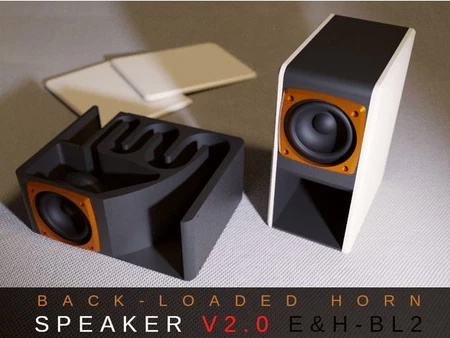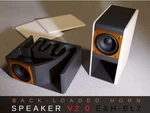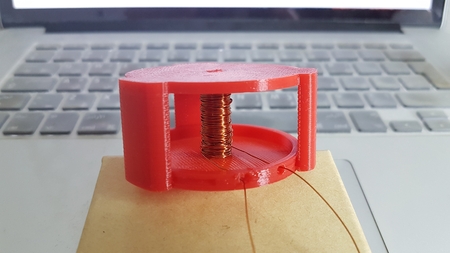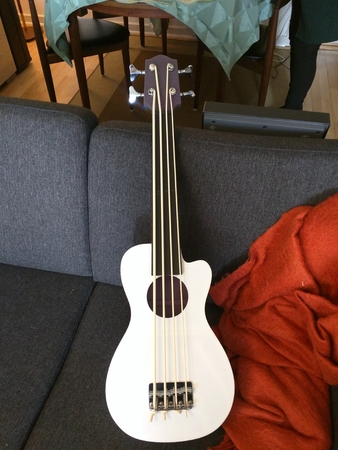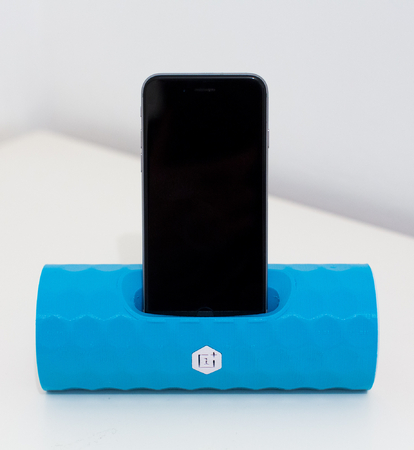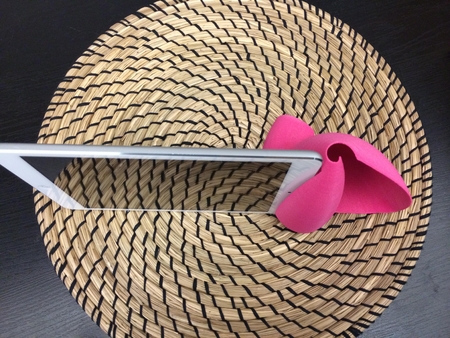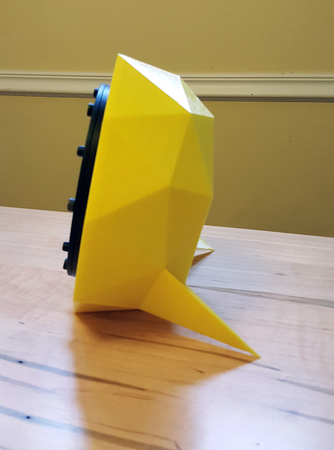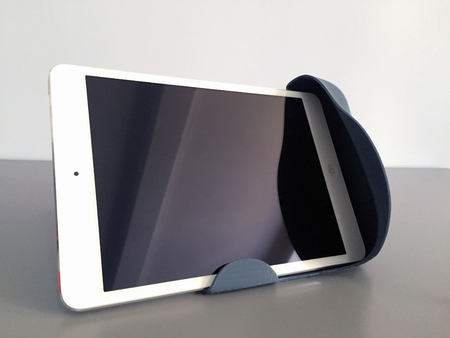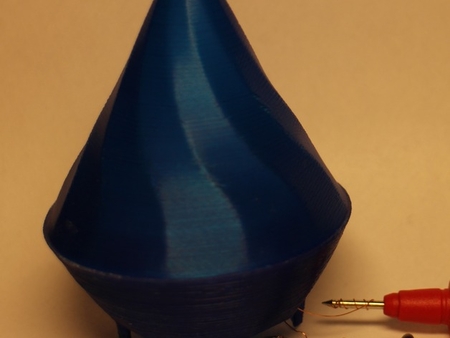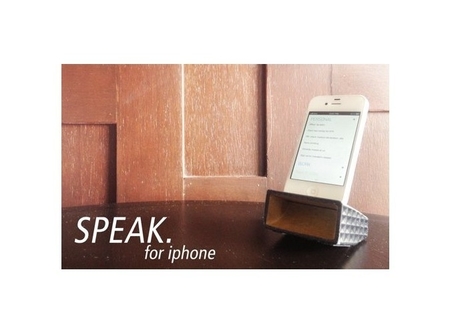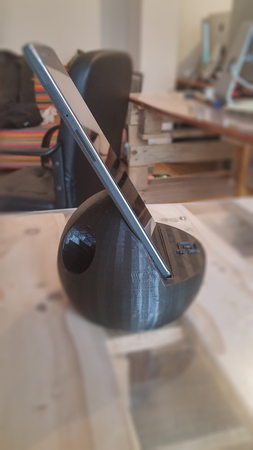Altavoz de bocina trasera v2. 0 bl2-bluetooth, activo, pasivo en 3D para imprimir
2535 Visualizaciones 2 Me gusta 0 Descargas realizadas Descarga aqui la pieza desde 3dforprint
Esta versión es un rediseño completo, igual de elegante, súper barato, totalmente imprimible PERO... con un sonido MUCHO mejor. Este altavoz Bluetooth de bocina con carga trasera utiliza un controlador de 3.3" (a diferencia del original de 2 1/2") y una placa Bluetooth de USD 1 y un amplificador de USD 3.5. El costo total debe ser de alrededor de USD 20. El gabinete con la bocina cargada hacia atrás (lea a continuación si no está familiarizado con el concepto) también es un rediseño completo.
Sin embargo, el concepto sigue siendo el mismo. Es como besar a la rana. Besas ese pequeño altavoz y esperas que se convierta en un príncipe. Y sí, lo hace... Es realmente sorprendente la cantidad de sonido que puede obtener de estos componentes ultrabaratos.
El gabinete es para un controlador de 3.3" (6.5 cm). Puedes usarlo como altavoz Bluetooth (como yo), activo o pasivo. Hay una cámara en la parte posterior para la electrónica (placa BT + amplificador).
Estoy usando esta placa decodificadora Bluetooth MP3 (aprox. USD 1)
además de un módulo amplificador TPA3116 D2 de Doble Canal 50Wx2 barato, esto es estéreo, por lo que los canales L y R de cable corto provienen de la placa BT
más cualquier fuente de alimentación de 12V/2A+
además de un pequeño convertidor reductor AMS1117/LM1117, este es para el módulo Bluetooth , que necesita 5V
El controlador que utilizo es un altavoz de rango completo Visaton FRS 8 M - 8 Ohm 8 cm (3.3") (alrededor de USD 12), que puede ser un poco difícil de encontrar. Sin embargo, https://www.amazon.com/s?k=3+full+range+speaker&crid=10S5BS828TTCK&sprefix=3"+full,aps,248&linkCode=sl2&tag=hthingsn08-20&linkId=2c8d992ffadcc95a3f5d8207f65fc6c5&language=en_US&ref_=as_li_ss_tl">la mayoría de los controladores de 3 a 3.5" deberían funcionar (advertencia, los orificios de montaje pueden variar). En esencia, cuanto mejor sea el controlador, mejor será el sonido que obtendrá de este diseño.
Sin embargo, si está dispuesto a gastar un poco más, por ejemplo, Aiyima tiene algunos conductores interesantes de 3-4" para elegir.
Puede encontrar una lista algo más detallada de suministros en mi Instructivo en https://www.instructables.com/Kissing-the-Frog-V20-Back-Horn-Bluetooth-Speaker-F/
Básicamente, cualquier combinación servirá (siempre que el controlador sea de 3.3" o más pequeño para que se ajuste al gabinete; si usa un controlador diferente, es posible que deba adaptar ligeramente los orificios de montaje o escalar el modelo). Este diseño y componentes están destinados a ser muy económicos. Cuanto mejores sean los componentes (especialmente el controlador), mejor será el sonido. En otras palabras, antes de besar a la rana, asegúrate de que tenga el corazón de un príncipe. xD
. OPCIÓN 2. Básicamente, todos los componentes electrónicos son opcionales. También puede usar V2. 0 como altavoz pasivo. Solo tienes que conectarlo a tu amplificador favorito. Actualmente estoy trabajando en un gabinete para que coincida con el diseño del altavoz basado en este amplificador: Placa amplificadora estéreo Bluetooth 5.0 TPA3116D2 de 2x50W. Muy contento con este tablero. Utiliza el mismo chip (TPA3116D2) que el amplificador que utilicé en V2.0, pero tiene una placa mucho mejor diseñada, sin ruido, tiene control de agudos y graves y un gran sonido. Estén atentos si eso es lo que están buscando. Publicaré el recinto tan pronto como esté terminado (espere alrededor de principios de enero). ACTUALIZACIÓN 08Jan21: El amplificador ya está en línea: https://www.thingiverse.com/thing:4713469
Imprimo el cuerpo principal con PLA de fibra de carbono súper barato y fácil de imprimir, lo que da una superficie hermosa, pero por supuesto servirá cualquier PLA / color.
Los paneles laterales podrían, por ejemplo, imprimirse en PLA de madera; se ve muy bien junto con el carbono y el cobre de seda,
y el anillo delantero en PLA de seda cobre / bronce.
Paneles laterales: Advertencia. En esencia, se trata de una carcasa de altavoz totalmente imprimible. Sin embargo, en mi experiencia, las superficies impresas tienden a ser muy ligeras y reflejan el sonido sorprendentemente bien, y los gabinetes que construí con paneles laterales de madera parecen sonar significativamente mejor que los que tienen paneles laterales impresos.
ACTUALIZACIÓN 08Dec20: A múltiples solicitudes, ¡acabo de agregar un diagrama de cableado! Espero que esto ayude.
CABLEADO. A pedido, aquí hay una breve introducción al cableado del altavoz (y recuerde, siempre puede usar el gabinete como un altavoz pasivo, lo que omite toda la soldadura).). ¡Necesitará habilidades básicas de electrónica y soldadura! Asegúrese de saber lo que está haciendo (especialmente cuando se trata de alto voltaje). ¡Todo bajo su propio riesgo y sin garantía de ningún tipo!
Esto es para la lista de suministros anterior y puede ser diferente si usa componentes diferentes. Conecte la salida del adaptador de corriente de 12 V a la ENTRADA DE ALIMENTACIÓN (marcada VCC y GND) en la placa amplificadora Y a la pequeña placa LM1117 (VIN y GND); La salida de 5 V (VOUT y GND) de la placa LM1117 está conectada a la entrada de alimentación en la placa BT.
Si (como yo) lo usa como un solo altavoz MONO, conecte la salida L y R que proviene de la placa BT (esto es importante, ¡le dará una señal mono, en lugar de medio estéreo!). Ahora conecta el puente L / R y GND de la placa BT a la entrada de línea (IN-L O IN-R y GND) del amplificador (si está utilizando un amplificador estéreo, conéctelo al canal izquierdo o derecho). Finalmente, conecte la salida del amplificador (L + y L-O R + y R-) al + y-del altavoz. Pruebe todo esto antes de montarlo en el gabinete (esto realmente ayuda con la resolución de problemas).
TEORÍA. Aquí una pequeña teoría: ¿Qué es un altavoz de bocina con carga trasera? Piensa en ello como un megáfono invertido o un gramófono. Un altavoz de bocina (frontal) utiliza una bocina acústica para aumentar la eficiencia general del elemento de accionamiento (es decir, el sonido que sale por la parte delantera). Un altavoz de bocina cargado hacia atrás hace más o menos lo mismo. Sin embargo, aquí la bocina está montada en la parte posterior del altavoz. Así que obtienen la salida directa de la parte delantera del controlador MÁS la de la bocina en la parte posterior. Qué frecuencias se amplifican y qué tan bien depende de la cámara de aire, la garganta (la parte estrecha) y la longitud, el diseño y el diámetro de la boca. Especialmente con controladores pequeños (y baratos), esto puede mejorar mucho la calidad del sonido.
ESPERO DE VERDAD QUE OS GUSTE Y SI OS GUSTA, POR FAVOR QUE OS GUSTE! ¡Gracias!
¡Que lo disfrutes!
Diseñador
e&h DesignDescripción del modelo 3d
Así que aquí está. Besando a la rana V2. 0.Esta versión es un rediseño completo, igual de elegante, súper barato, totalmente imprimible PERO... con un sonido MUCHO mejor. Este altavoz Bluetooth de bocina con carga trasera utiliza un controlador de 3.3" (a diferencia del original de 2 1/2") y una placa Bluetooth de USD 1 y un amplificador de USD 3.5. El costo total debe ser de alrededor de USD 20. El gabinete con la bocina cargada hacia atrás (lea a continuación si no está familiarizado con el concepto) también es un rediseño completo.
Sin embargo, el concepto sigue siendo el mismo. Es como besar a la rana. Besas ese pequeño altavoz y esperas que se convierta en un príncipe. Y sí, lo hace... Es realmente sorprendente la cantidad de sonido que puede obtener de estos componentes ultrabaratos.
El gabinete es para un controlador de 3.3" (6.5 cm). Puedes usarlo como altavoz Bluetooth (como yo), activo o pasivo. Hay una cámara en la parte posterior para la electrónica (placa BT + amplificador).
Estoy usando esta placa decodificadora Bluetooth MP3 (aprox. USD 1)
además de un módulo amplificador TPA3116 D2 de Doble Canal 50Wx2 barato, esto es estéreo, por lo que los canales L y R de cable corto provienen de la placa BT
más cualquier fuente de alimentación de 12V/2A+
además de un pequeño convertidor reductor AMS1117/LM1117, este es para el módulo Bluetooth , que necesita 5V
El controlador que utilizo es un altavoz de rango completo Visaton FRS 8 M - 8 Ohm 8 cm (3.3") (alrededor de USD 12), que puede ser un poco difícil de encontrar. Sin embargo, https://www.amazon.com/s?k=3+full+range+speaker&crid=10S5BS828TTCK&sprefix=3"+full,aps,248&linkCode=sl2&tag=hthingsn08-20&linkId=2c8d992ffadcc95a3f5d8207f65fc6c5&language=en_US&ref_=as_li_ss_tl">la mayoría de los controladores de 3 a 3.5" deberían funcionar (advertencia, los orificios de montaje pueden variar). En esencia, cuanto mejor sea el controlador, mejor será el sonido que obtendrá de este diseño.
Sin embargo, si está dispuesto a gastar un poco más, por ejemplo, Aiyima tiene algunos conductores interesantes de 3-4" para elegir.
Puede encontrar una lista algo más detallada de suministros en mi Instructivo en https://www.instructables.com/Kissing-the-Frog-V20-Back-Horn-Bluetooth-Speaker-F/
Básicamente, cualquier combinación servirá (siempre que el controlador sea de 3.3" o más pequeño para que se ajuste al gabinete; si usa un controlador diferente, es posible que deba adaptar ligeramente los orificios de montaje o escalar el modelo). Este diseño y componentes están destinados a ser muy económicos. Cuanto mejores sean los componentes (especialmente el controlador), mejor será el sonido. En otras palabras, antes de besar a la rana, asegúrate de que tenga el corazón de un príncipe. xD
. OPCIÓN 2. Básicamente, todos los componentes electrónicos son opcionales. También puede usar V2. 0 como altavoz pasivo. Solo tienes que conectarlo a tu amplificador favorito. Actualmente estoy trabajando en un gabinete para que coincida con el diseño del altavoz basado en este amplificador: Placa amplificadora estéreo Bluetooth 5.0 TPA3116D2 de 2x50W. Muy contento con este tablero. Utiliza el mismo chip (TPA3116D2) que el amplificador que utilicé en V2.0, pero tiene una placa mucho mejor diseñada, sin ruido, tiene control de agudos y graves y un gran sonido. Estén atentos si eso es lo que están buscando. Publicaré el recinto tan pronto como esté terminado (espere alrededor de principios de enero). ACTUALIZACIÓN 08Jan21: El amplificador ya está en línea: https://www.thingiverse.com/thing:4713469
Parametros de impresión 3d
IMPRESIÓN. Esta debe ser una impresión simple. Notarás que el cuerpo tiene una cubierta de 1 mm en un lado (si no quieres esto, por ejemplo, porque... estás usando paneles laterales transparentes, he agregado una versión del cuerpo que no tiene "FONDO" agregado, de lo contrario, use el cuerpo estándar CON la cubierta de 1 mm!). Esto es para darle más estabilidad y facilitar la impresión y extracción de la impresora. No se necesitan soportes ni accesorios. Impresión en PLA (o ABS, PETG...) a una resolución de 0,28 mm y (alrededor de) un 15% de relleno. Los paneles laterales se pueden imprimir o cortar (15 x 20 cm) de madera contrachapada de 6-8 mm(yo uso haya). Acople la parte frontal y el altavoz (originalmente, el controlador estaba destinado a montarse desde el interior, pero también puede montarlo desde el exterior, lo que facilita realizar cambios en una etapa posterior) con tornillos M3 y el panel posterior que también cubre el compartimento electrónico. Pega los paneles laterales al cuerpo. Los pies (los imprimo en TPU) son opcionales. He incluido un dibujo en PDF 1: 2 de los paneles laterales si prefiere cortarlos de madera (como yo).Imprimo el cuerpo principal con PLA de fibra de carbono súper barato y fácil de imprimir, lo que da una superficie hermosa, pero por supuesto servirá cualquier PLA / color.
Los paneles laterales podrían, por ejemplo, imprimirse en PLA de madera; se ve muy bien junto con el carbono y el cobre de seda,
y el anillo delantero en PLA de seda cobre / bronce.
Paneles laterales: Advertencia. En esencia, se trata de una carcasa de altavoz totalmente imprimible. Sin embargo, en mi experiencia, las superficies impresas tienden a ser muy ligeras y reflejan el sonido sorprendentemente bien, y los gabinetes que construí con paneles laterales de madera parecen sonar significativamente mejor que los que tienen paneles laterales impresos.
ACTUALIZACIÓN 08Dec20: A múltiples solicitudes, ¡acabo de agregar un diagrama de cableado! Espero que esto ayude.
CABLEADO. A pedido, aquí hay una breve introducción al cableado del altavoz (y recuerde, siempre puede usar el gabinete como un altavoz pasivo, lo que omite toda la soldadura).). ¡Necesitará habilidades básicas de electrónica y soldadura! Asegúrese de saber lo que está haciendo (especialmente cuando se trata de alto voltaje). ¡Todo bajo su propio riesgo y sin garantía de ningún tipo!
Esto es para la lista de suministros anterior y puede ser diferente si usa componentes diferentes. Conecte la salida del adaptador de corriente de 12 V a la ENTRADA DE ALIMENTACIÓN (marcada VCC y GND) en la placa amplificadora Y a la pequeña placa LM1117 (VIN y GND); La salida de 5 V (VOUT y GND) de la placa LM1117 está conectada a la entrada de alimentación en la placa BT.
Si (como yo) lo usa como un solo altavoz MONO, conecte la salida L y R que proviene de la placa BT (esto es importante, ¡le dará una señal mono, en lugar de medio estéreo!). Ahora conecta el puente L / R y GND de la placa BT a la entrada de línea (IN-L O IN-R y GND) del amplificador (si está utilizando un amplificador estéreo, conéctelo al canal izquierdo o derecho). Finalmente, conecte la salida del amplificador (L + y L-O R + y R-) al + y-del altavoz. Pruebe todo esto antes de montarlo en el gabinete (esto realmente ayuda con la resolución de problemas).
TEORÍA. Aquí una pequeña teoría: ¿Qué es un altavoz de bocina con carga trasera? Piensa en ello como un megáfono invertido o un gramófono. Un altavoz de bocina (frontal) utiliza una bocina acústica para aumentar la eficiencia general del elemento de accionamiento (es decir, el sonido que sale por la parte delantera). Un altavoz de bocina cargado hacia atrás hace más o menos lo mismo. Sin embargo, aquí la bocina está montada en la parte posterior del altavoz. Así que obtienen la salida directa de la parte delantera del controlador MÁS la de la bocina en la parte posterior. Qué frecuencias se amplifican y qué tan bien depende de la cámara de aire, la garganta (la parte estrecha) y la longitud, el diseño y el diámetro de la boca. Especialmente con controladores pequeños (y baratos), esto puede mejorar mucho la calidad del sonido.
ESPERO DE VERDAD QUE OS GUSTE Y SI OS GUSTA, POR FAVOR QUE OS GUSTE! ¡Gracias!
¡Que lo disfrutes!
